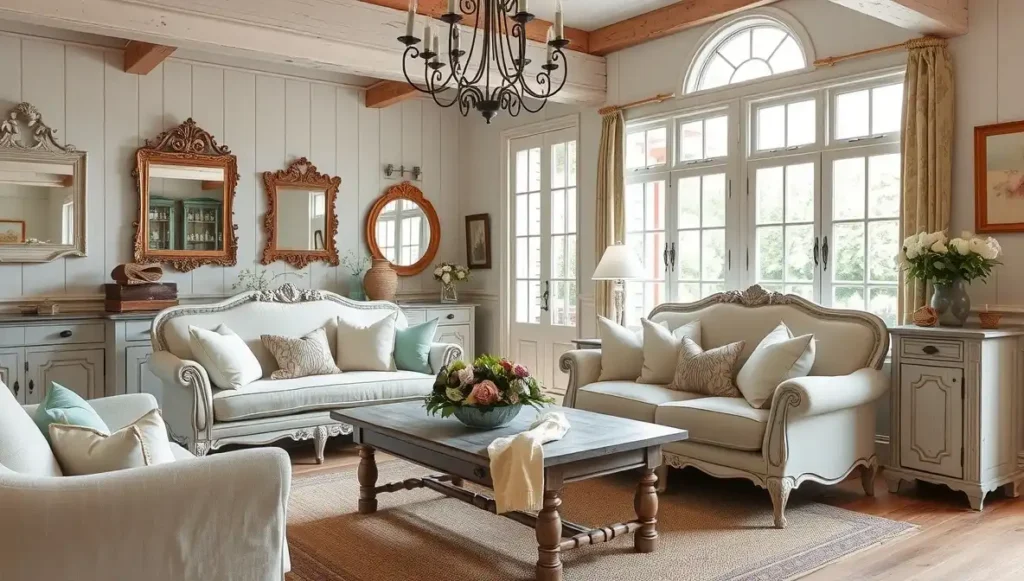- Why Vintage Interior Design Still Has My Heart - September 3, 2025
- Still in Love with Traditional Design – And Here’s Why - September 3, 2025
- The Enduring Charm of English Country Design: Why This Style Never Goes Out of Fashion - September 2, 2025
Table of Contents
I’ll be honest with you. After twenty-something years of doing this job, I’ve seen every trend imaginable. Remember when everything had to be minimalist white? Or that phase where everyone wanted their living room to look like a hotel lobby? But French Country? That’s different. It’s stuck around because it actually makes sense.
Here’s What I Love About French Country Design
You know when you walk into some houses and just feel… right? Like someone could offer you a cup of coffee and you’d actually want to stick around? That’s what French Country does. I’ve worked on these crazy expensive modern houses where everything’s perfect, but they feel about as welcoming as a doctor’s office. Then I’ll visit a little cottage done in French Country style, and boom, I’m mentally rearranging my schedule to stay longer.
Here’s the thing, this look didn’t come from some fancy designer sitting in Paris. It came from regular people who needed their homes to actually work. They wanted pretty, sure, but they also needed sturdy tables for bread-making and chairs that could handle daily use. Turns out, when you design for real life first, you accidentally create something beautiful.
I remember this one client, Sarah, who called me because her house felt “too perfect.” She’d spent a fortune on modern furniture, and everything looked like a magazine spread. But she hated being in her own living room. Six months later, after we’d introduced some weathered wood pieces and swapped out those stark white walls for warm cream, she told me her house finally felt like home. That’s her room now.
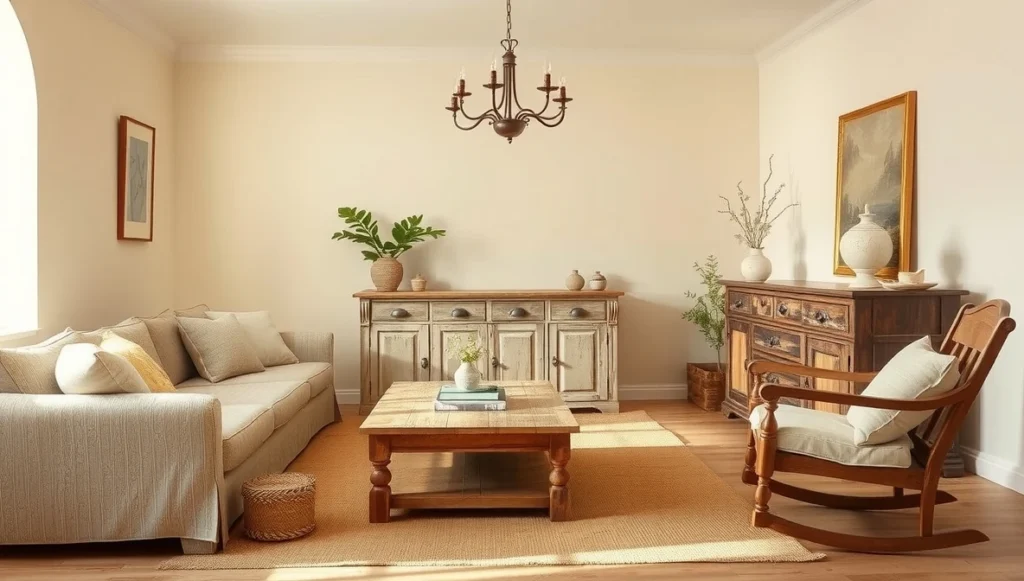
The Colors That Actually Work (And the Ones That Don’t)
Look, I’m going to save you from making the same mistakes I’ve watched people make for twenty years. Everyone thinks French Country means painting everything bright yellow and blue because they saw it in some travel magazine. Wrong.
Picture this: take any bright color and leave it sitting in a sunny window for about five years. See how it gets all soft and faded? That’s your French Country palette right there. The blue turns into something like old jeans that have been washed a million times. The yellow becomes more like… I don’t know, maybe vanilla ice cream that’s been sitting out a bit.
I stick with colors that look like they have stories. Creamy whites that aren’t trying to blind you, greens that remind you of picking herbs in a garden, blues that feel like worn denim. Sometimes I’ll add a tiny bit of dusty rose or lavender, but just enough to make things interesting. French Country works best when the colors feel like they’ve aged gracefully. You can mix several shades, but they should look softened, sun-faded, and naturally connected – never loud or jarring.
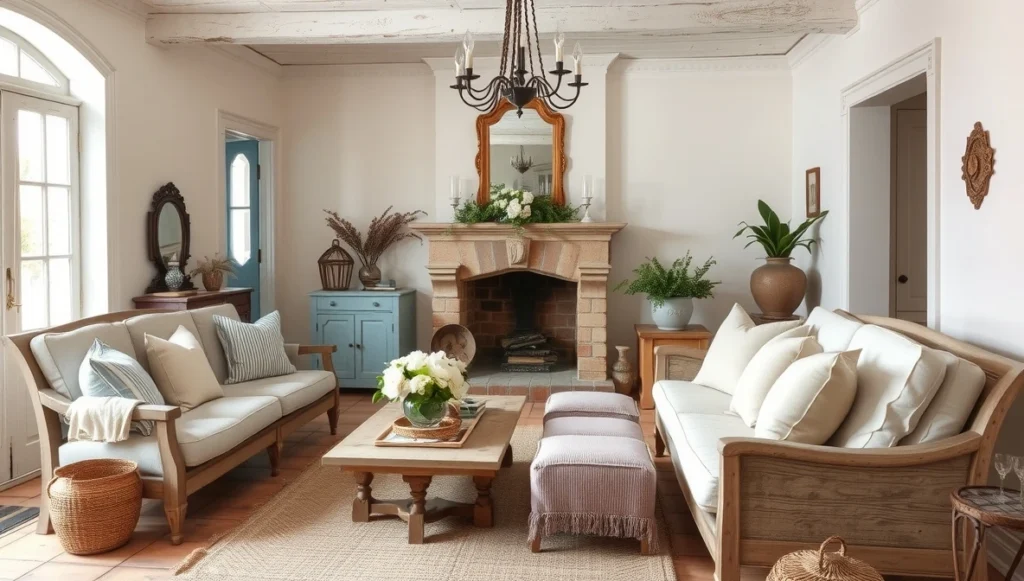
The biggest mistake? Going too bright. I had one client who painted her kitchen “Provence Yellow” – and it looked like a taxi cab. We toned it down with a glaze, and suddenly it looked authentically French instead of like a themed restaurant. Here it is.
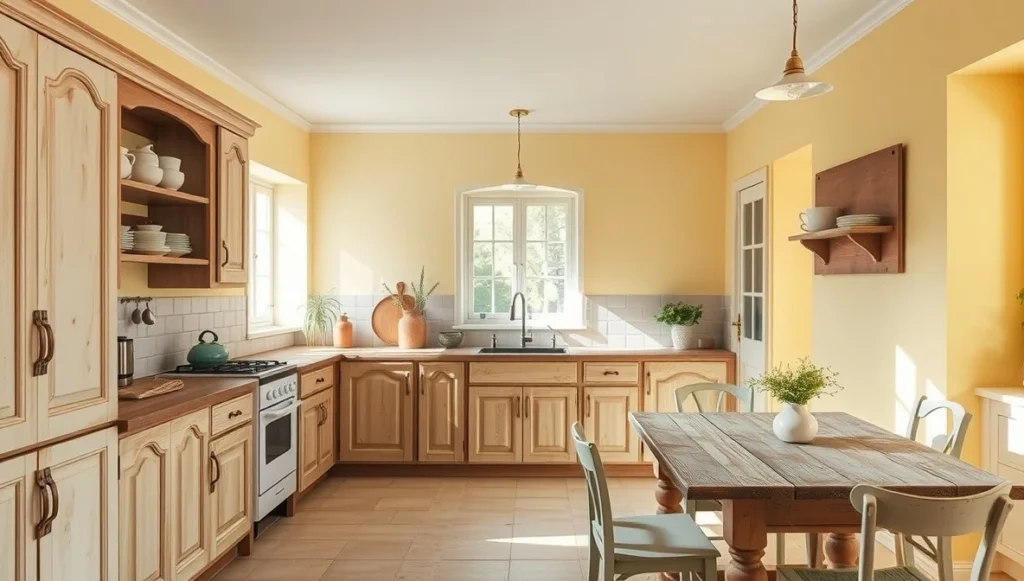
Materials That Get Better With Age
This whole style basically celebrates the beauty of things getting a little beat up. Weird concept, right? But stick with me here.
You want wood that looks like it’s been through some stuff. Not destroyed – just… lived in. I’m talking about barn wood that’s got some character, old crates that someone’s grandfather might have used, dining tables where you can see little dents from years of family chaos.
There’s this armoire I found at an estate sale once – thing was a mess. Paint peeling off, one door hung crooked, scratches everywhere. The woman selling it apologized for its condition. I bought it on the spot. My client’s mom thought we’d lost our minds, but now it’s the most complimented piece in her bedroom. Sometimes the “flaws” are exactly what make something perfect. Check it out.
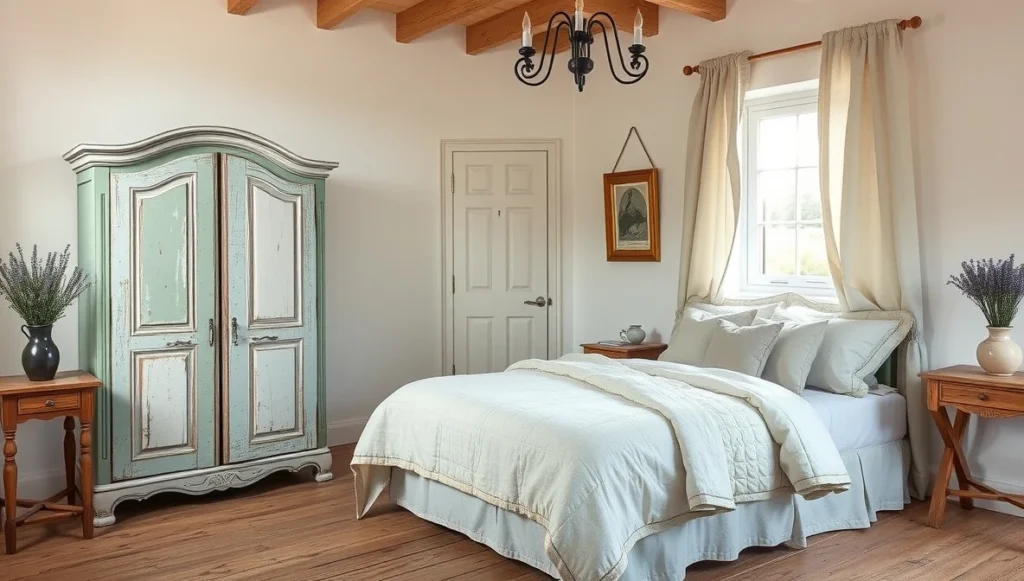
And fabrics? Forget anything that stays wrinkle-free or stain-resistant. You want linen that looks rumpled the second someone sits on it, cotton that gets softer every time it hits the washing machine, wool that just keeps getting better with age. These materials age like good wine. They actually improve over time instead of just wearing out.
Room by Room: Making It Work
Kitchens Where You Actually Want to Cook
French Country kitchens just work better than other kitchens. I don’t know how else to put it. They’re pretty enough that you don’t mind people seeing them, but practical enough that you can actually make a mess without panicking.
Open shelves are a great deal here, not because they’re trendy. They’re there because when you’re cooking, you want to grab a bowl without opening fifteen cabinet doors. Plus, if you’ve got nice dishes, why hide them?
The cabinets should look like furniture, not kitchen cabinets. I paint them in soft colors, rough them up a little bit, and put on hardware that feels substantial in your hand. The whole point is making it look like someone’s great-grandmother’s kitchen, not something that rolled off a factory line.
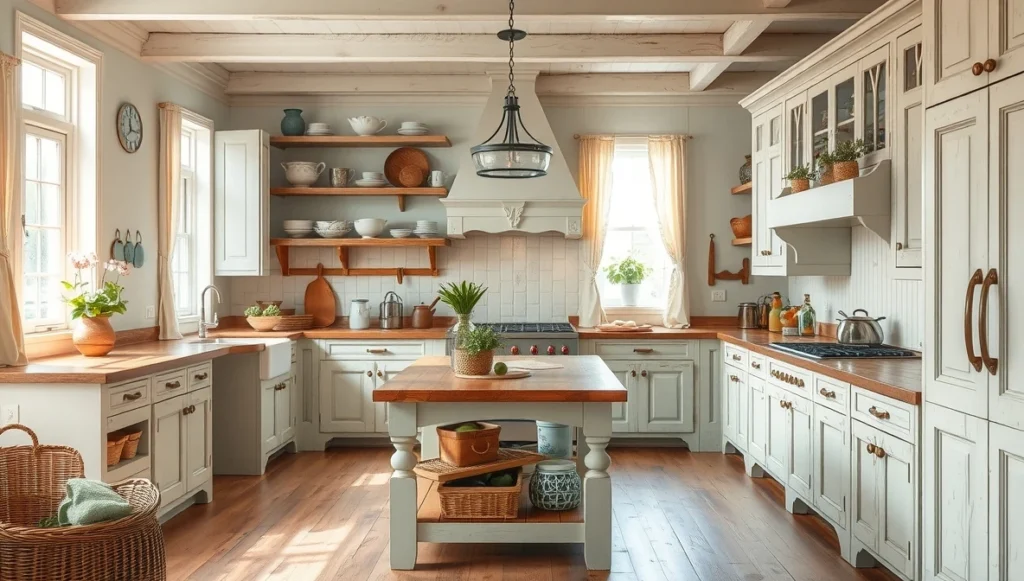
Bedrooms for Actual Sleeping
I want bedrooms that make people want to take naps. Start with a wooden bed that’s got some curves to it, nothing too sharp or modern. Then just pile on the textiles until it looks like somewhere you’d want to spend a Sunday morning.
Here’s a trick that works every time: use about three different shades of white or cream in your bedding. Sounds boring, but it’s not. Pure white looks like a hotel, but when you mix in some ivory and maybe a little bit of pale gray, suddenly you’ve got depth and it looks expensive.
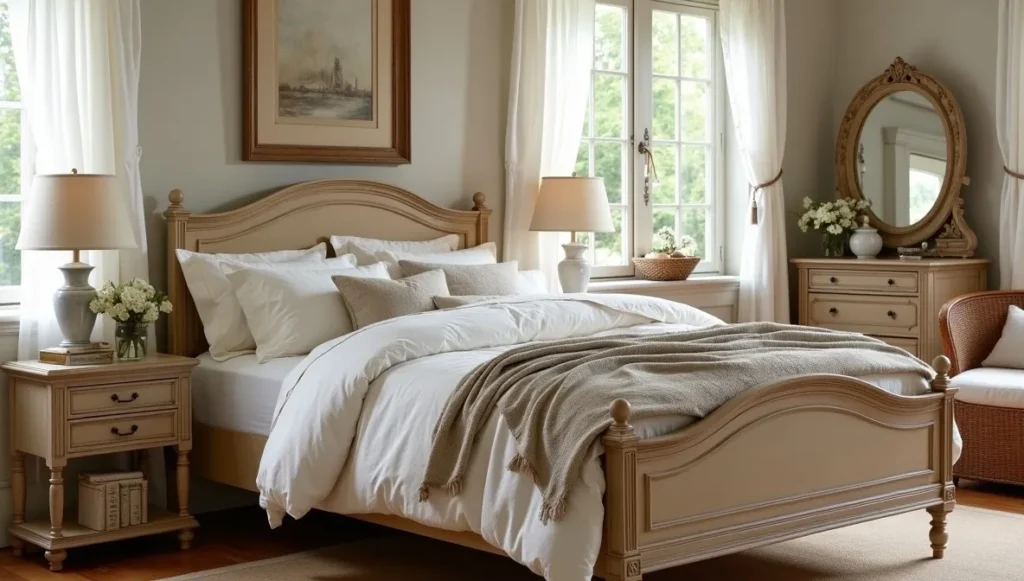
Living Rooms Where People Actually Hang Out
Okay, this might sound obvious, but I set up living rooms so people can look at each other when they talk. Crazy concept, right? You’d be amazed how many houses I walk into where all the furniture faces the TV like it’s some kind of altar.
Lighting’s everything in these rooms. Those awful ceiling fixtures that make everyone look like they’re in an interrogation room? Nope. I’m all about lamps scattered around the room and candles everywhere. Makes people look good, makes the room feel warm. Win-win.
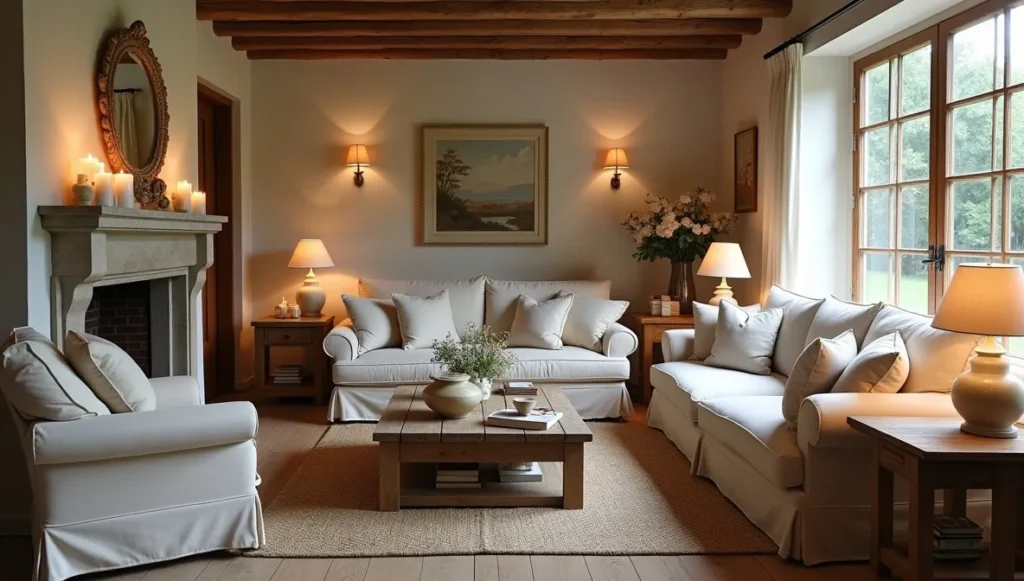
Bathrooms You Don’t Want to Leave
Who says bathrooms have to be boring? I’ve done some French Country bathrooms that are honestly nicer than most people’s living rooms. Clawfoot tubs, old-fashioned sinks that look like furniture, maybe some weathered wood shelving.
I turned this one ugly builder-grade bathroom into something that looked like it belonged in a French bed-and-breakfast. The client now takes baths instead of quick showers because the room’s actually pleasant to be in.
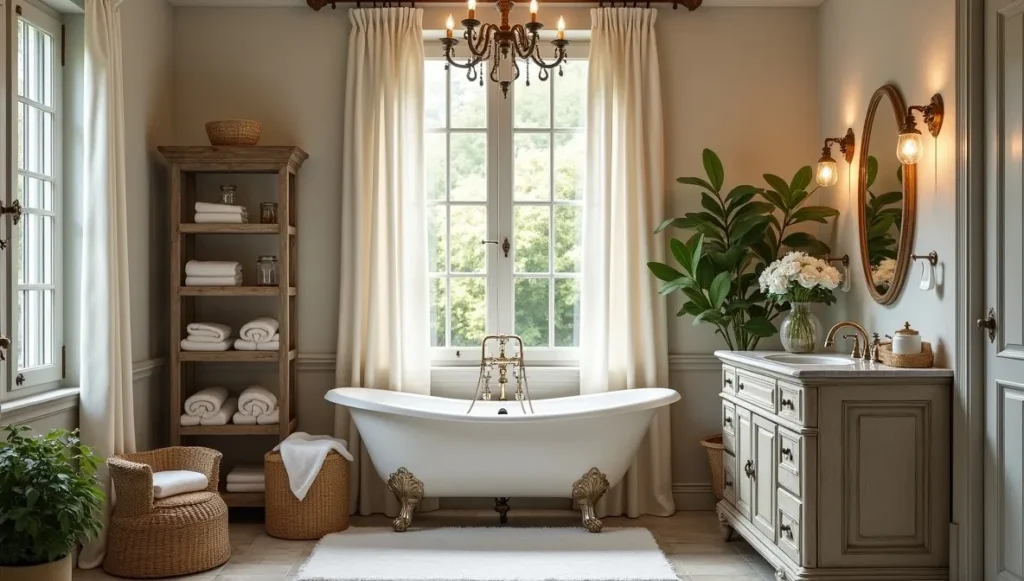
Kids’ Rooms That Don’t Look Ridiculous Later
Kids’ rooms are tricky because what looks cute at five becomes embarrassing at fifteen. I learned this the hard way with my own daughter’s room years ago. We went full princess theme, and by middle school, she was mortified.
Now I start with colors that’ll work whether they’re seven or seventeen. Soft blues, gentle greams, maybe a pale yellow. Then I add character with furniture that can grow with them, like a good wooden bed, storage that doesn’t scream “toy box,” maybe an old desk where they can do homework for years.
The secret? Let them add their own personality with stuff that’s easy to change. Bedding, posters, collections of whatever they’re into that week. The room stays classic, but they can make it theirs.
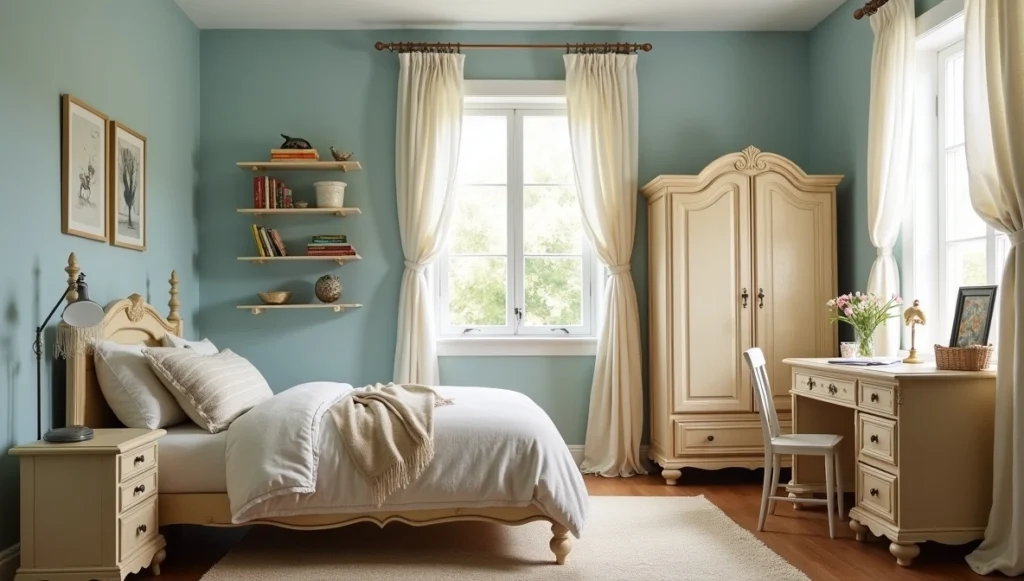
What Usually Goes Wrong (And How to Fix It)
Here’s what drives me nuts: people who think they need to turn their house into some kind of French museum. I walk into these places and there are roosters everywhere. Rooster curtains, rooster dishes, rooster doorstops, probably a rooster toilet seat cover somewhere. It’s too much.
I had this client once who’d gone completely overboard. Her kitchen looked like a gift shop in Provence threw up all over it. We kept exactly one piece – this really beautiful old weathervane – and got rid of everything else. Suddenly her kitchen went from looking like a theme park to looking like an actual home.
Here’s another thing: size matters. That massive armoire might be gorgeous and authentic and cost you a month’s salary, but if it makes your bedroom look like a dollhouse, it’s wrong for the space. I don’t care how perfect it is – if the proportions are off, the whole room feels weird.
And please, don’t make everything look brand new and then try to call it French Country. The gentle wear and patina aren’t optional – they’re what make the style work.
Making It Work in Today’s Homes
Listen, you can have your smart fridge and your fancy coffee machine. French Country doesn’t mean living like it’s 1823. It just means being smart about how you hide the modern stuff.
In kitchens, I’ll panel over appliances so they look like they belong, or I’ll hunt down appliances in colors that don’t scream “LOOK AT ME I’M FROM 2025!” A cream-colored dishwasher blends in way better than stainless steel that reflects light like a mirror.
For home offices – because everyone needs those now – I just pretend I’m setting up a study in an old French farmhouse. Big wooden desk, comfortable chair, good lighting. Add some books and maybe a pretty lamp, and you’re done. Work gets done, room looks good.
Finding the Right Pieces
I’ve developed relationships with estate sale companies and antique dealers over the years. But even if you’re shopping on your own, look for real patina – it can’t be faked easily. Don’t be afraid of pieces that need a little work. Some of my favorite finds were diamonds in the rough.
And remember, you don’t need to find everything at once. Building a collection over time makes the rooms feel more authentic, like they evolved naturally.
Why This Style Endures
You want to know why French Country never really goes out of style? Because it was never about impressing people in the first place. It was about creating homes that work for the people who live in them.
In a world where everything moves so fast, there’s real comfort in design that connects us to simpler times. I’ve seen clients try every trendy style imaginable, always chasing the next big thing. But the ones who choose French Country? They stick with it. Because once you create a home that truly feels like home, why would you change it?
French Country isn’t about following rules or buying the right accessories. It’s about understanding that real beauty comes from authenticity, comfort, and the accumulated layers of daily life.
